Employee Motivation's Impact on Organisational Productivity
VerifiedAdded on 2023/01/12
|16
|5022
|80
Report
AI Summary
This business research plan investigates the critical link between employee motivation and organisational productivity, using Marks & Spencer as a case study. The plan outlines research aims, objectives, and questions, alongside a literature review exploring the significance of motivation, strategies for motivating employees, and the impact on performance. It details the research methodology, including the interpretivism philosophy, inductive approach, and a comprehensive research onion framework. The plan covers sampling, accessibility, ethical considerations, deliverables, resources, and a timeline. Furthermore, it provides an evaluation of the research choices made. The research aims to analyze the benefits of a motivated workforce, including increased retention, engagement, and productivity, ultimately contributing to a positive workplace culture and improved business outcomes. The report is structured to provide a thorough understanding of the topic.
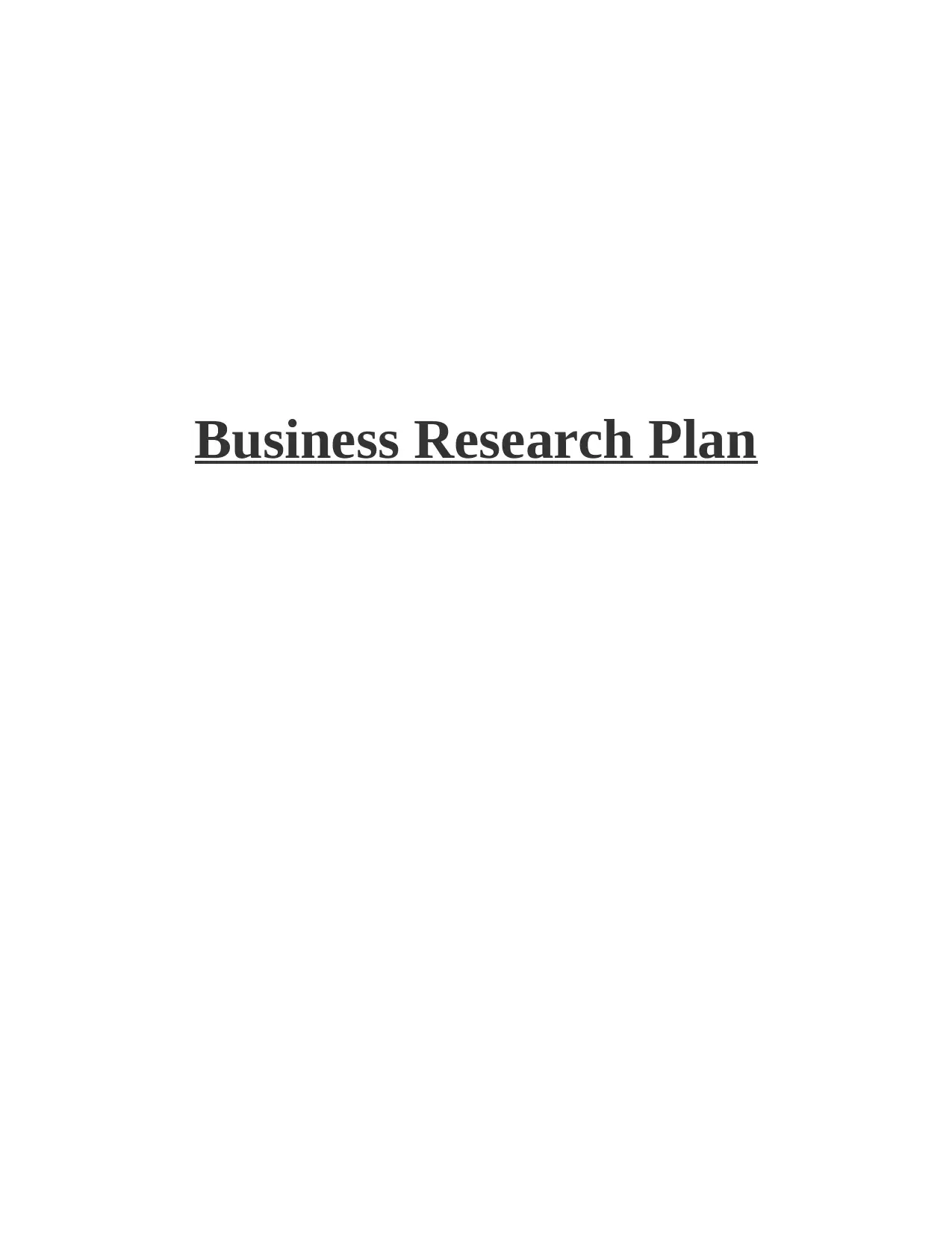
Business Research Plan
Paraphrase This Document
Need a fresh take? Get an instant paraphrase of this document with our AI Paraphraser
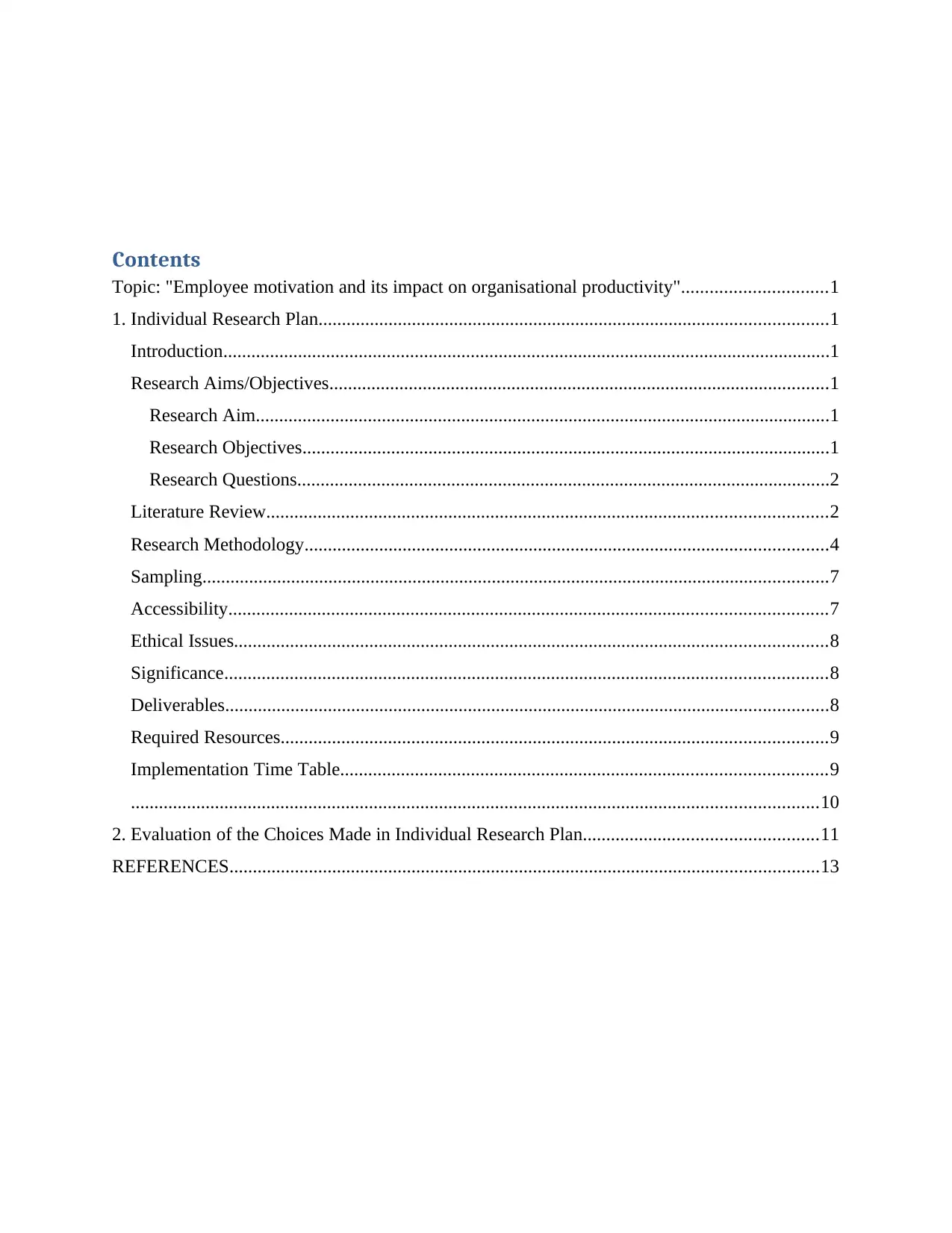
Contents
Topic: "Employee motivation and its impact on organisational productivity"...............................1
1. Individual Research Plan.............................................................................................................1
Introduction..................................................................................................................................1
Research Aims/Objectives...........................................................................................................1
Research Aim...........................................................................................................................1
Research Objectives.................................................................................................................1
Research Questions..................................................................................................................2
Literature Review........................................................................................................................2
Research Methodology................................................................................................................4
Sampling......................................................................................................................................7
Accessibility................................................................................................................................7
Ethical Issues...............................................................................................................................8
Significance.................................................................................................................................8
Deliverables.................................................................................................................................8
Required Resources.....................................................................................................................9
Implementation Time Table........................................................................................................9
...................................................................................................................................................10
2. Evaluation of the Choices Made in Individual Research Plan..................................................11
REFERENCES..............................................................................................................................13
Topic: "Employee motivation and its impact on organisational productivity"...............................1
1. Individual Research Plan.............................................................................................................1
Introduction..................................................................................................................................1
Research Aims/Objectives...........................................................................................................1
Research Aim...........................................................................................................................1
Research Objectives.................................................................................................................1
Research Questions..................................................................................................................2
Literature Review........................................................................................................................2
Research Methodology................................................................................................................4
Sampling......................................................................................................................................7
Accessibility................................................................................................................................7
Ethical Issues...............................................................................................................................8
Significance.................................................................................................................................8
Deliverables.................................................................................................................................8
Required Resources.....................................................................................................................9
Implementation Time Table........................................................................................................9
...................................................................................................................................................10
2. Evaluation of the Choices Made in Individual Research Plan..................................................11
REFERENCES..............................................................................................................................13
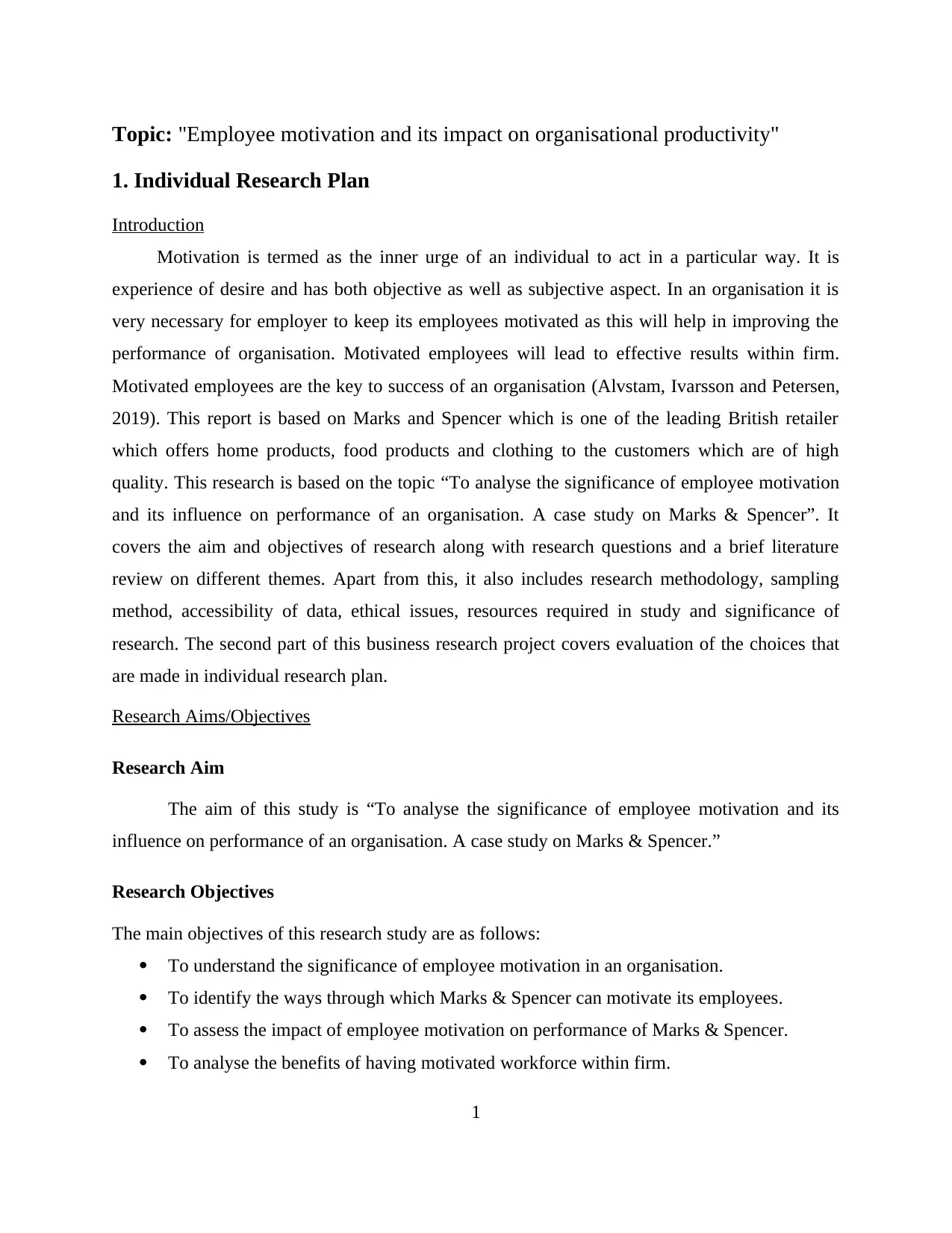
Topic: "Employee motivation and its impact on organisational productivity"
1. Individual Research Plan
Introduction
Motivation is termed as the inner urge of an individual to act in a particular way. It is
experience of desire and has both objective as well as subjective aspect. In an organisation it is
very necessary for employer to keep its employees motivated as this will help in improving the
performance of organisation. Motivated employees will lead to effective results within firm.
Motivated employees are the key to success of an organisation (Alvstam, Ivarsson and Petersen,
2019). This report is based on Marks and Spencer which is one of the leading British retailer
which offers home products, food products and clothing to the customers which are of high
quality. This research is based on the topic “To analyse the significance of employee motivation
and its influence on performance of an organisation. A case study on Marks & Spencer”. It
covers the aim and objectives of research along with research questions and a brief literature
review on different themes. Apart from this, it also includes research methodology, sampling
method, accessibility of data, ethical issues, resources required in study and significance of
research. The second part of this business research project covers evaluation of the choices that
are made in individual research plan.
Research Aims/Objectives
Research Aim
The aim of this study is “To analyse the significance of employee motivation and its
influence on performance of an organisation. A case study on Marks & Spencer.”
Research Objectives
The main objectives of this research study are as follows:
To understand the significance of employee motivation in an organisation.
To identify the ways through which Marks & Spencer can motivate its employees.
To assess the impact of employee motivation on performance of Marks & Spencer.
To analyse the benefits of having motivated workforce within firm.
1
1. Individual Research Plan
Introduction
Motivation is termed as the inner urge of an individual to act in a particular way. It is
experience of desire and has both objective as well as subjective aspect. In an organisation it is
very necessary for employer to keep its employees motivated as this will help in improving the
performance of organisation. Motivated employees will lead to effective results within firm.
Motivated employees are the key to success of an organisation (Alvstam, Ivarsson and Petersen,
2019). This report is based on Marks and Spencer which is one of the leading British retailer
which offers home products, food products and clothing to the customers which are of high
quality. This research is based on the topic “To analyse the significance of employee motivation
and its influence on performance of an organisation. A case study on Marks & Spencer”. It
covers the aim and objectives of research along with research questions and a brief literature
review on different themes. Apart from this, it also includes research methodology, sampling
method, accessibility of data, ethical issues, resources required in study and significance of
research. The second part of this business research project covers evaluation of the choices that
are made in individual research plan.
Research Aims/Objectives
Research Aim
The aim of this study is “To analyse the significance of employee motivation and its
influence on performance of an organisation. A case study on Marks & Spencer.”
Research Objectives
The main objectives of this research study are as follows:
To understand the significance of employee motivation in an organisation.
To identify the ways through which Marks & Spencer can motivate its employees.
To assess the impact of employee motivation on performance of Marks & Spencer.
To analyse the benefits of having motivated workforce within firm.
1
⊘ This is a preview!⊘
Do you want full access?
Subscribe today to unlock all pages.

Trusted by 1+ million students worldwide
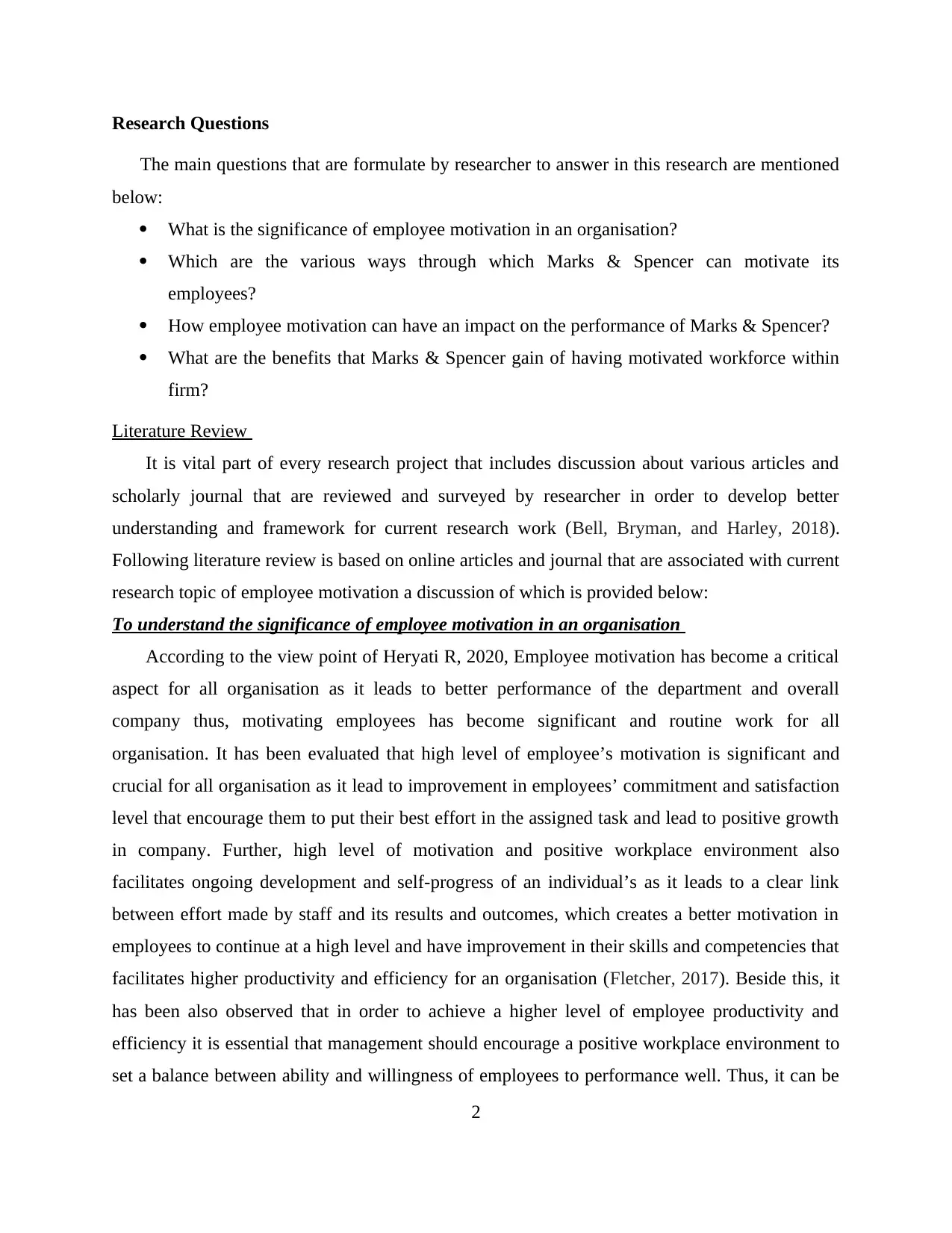
Research Questions
The main questions that are formulate by researcher to answer in this research are mentioned
below:
What is the significance of employee motivation in an organisation?
Which are the various ways through which Marks & Spencer can motivate its
employees?
How employee motivation can have an impact on the performance of Marks & Spencer?
What are the benefits that Marks & Spencer gain of having motivated workforce within
firm?
Literature Review
It is vital part of every research project that includes discussion about various articles and
scholarly journal that are reviewed and surveyed by researcher in order to develop better
understanding and framework for current research work (Bell, Bryman, and Harley, 2018).
Following literature review is based on online articles and journal that are associated with current
research topic of employee motivation a discussion of which is provided below:
To understand the significance of employee motivation in an organisation
According to the view point of Heryati R, 2020, Employee motivation has become a critical
aspect for all organisation as it leads to better performance of the department and overall
company thus, motivating employees has become significant and routine work for all
organisation. It has been evaluated that high level of employee’s motivation is significant and
crucial for all organisation as it lead to improvement in employees’ commitment and satisfaction
level that encourage them to put their best effort in the assigned task and lead to positive growth
in company. Further, high level of motivation and positive workplace environment also
facilitates ongoing development and self-progress of an individual’s as it leads to a clear link
between effort made by staff and its results and outcomes, which creates a better motivation in
employees to continue at a high level and have improvement in their skills and competencies that
facilitates higher productivity and efficiency for an organisation (Fletcher, 2017). Beside this, it
has been also observed that in order to achieve a higher level of employee productivity and
efficiency it is essential that management should encourage a positive workplace environment to
set a balance between ability and willingness of employees to performance well. Thus, it can be
2
The main questions that are formulate by researcher to answer in this research are mentioned
below:
What is the significance of employee motivation in an organisation?
Which are the various ways through which Marks & Spencer can motivate its
employees?
How employee motivation can have an impact on the performance of Marks & Spencer?
What are the benefits that Marks & Spencer gain of having motivated workforce within
firm?
Literature Review
It is vital part of every research project that includes discussion about various articles and
scholarly journal that are reviewed and surveyed by researcher in order to develop better
understanding and framework for current research work (Bell, Bryman, and Harley, 2018).
Following literature review is based on online articles and journal that are associated with current
research topic of employee motivation a discussion of which is provided below:
To understand the significance of employee motivation in an organisation
According to the view point of Heryati R, 2020, Employee motivation has become a critical
aspect for all organisation as it leads to better performance of the department and overall
company thus, motivating employees has become significant and routine work for all
organisation. It has been evaluated that high level of employee’s motivation is significant and
crucial for all organisation as it lead to improvement in employees’ commitment and satisfaction
level that encourage them to put their best effort in the assigned task and lead to positive growth
in company. Further, high level of motivation and positive workplace environment also
facilitates ongoing development and self-progress of an individual’s as it leads to a clear link
between effort made by staff and its results and outcomes, which creates a better motivation in
employees to continue at a high level and have improvement in their skills and competencies that
facilitates higher productivity and efficiency for an organisation (Fletcher, 2017). Beside this, it
has been also observed that in order to achieve a higher level of employee productivity and
efficiency it is essential that management should encourage a positive workplace environment to
set a balance between ability and willingness of employees to performance well. Thus, it can be
2
Paraphrase This Document
Need a fresh take? Get an instant paraphrase of this document with our AI Paraphraser
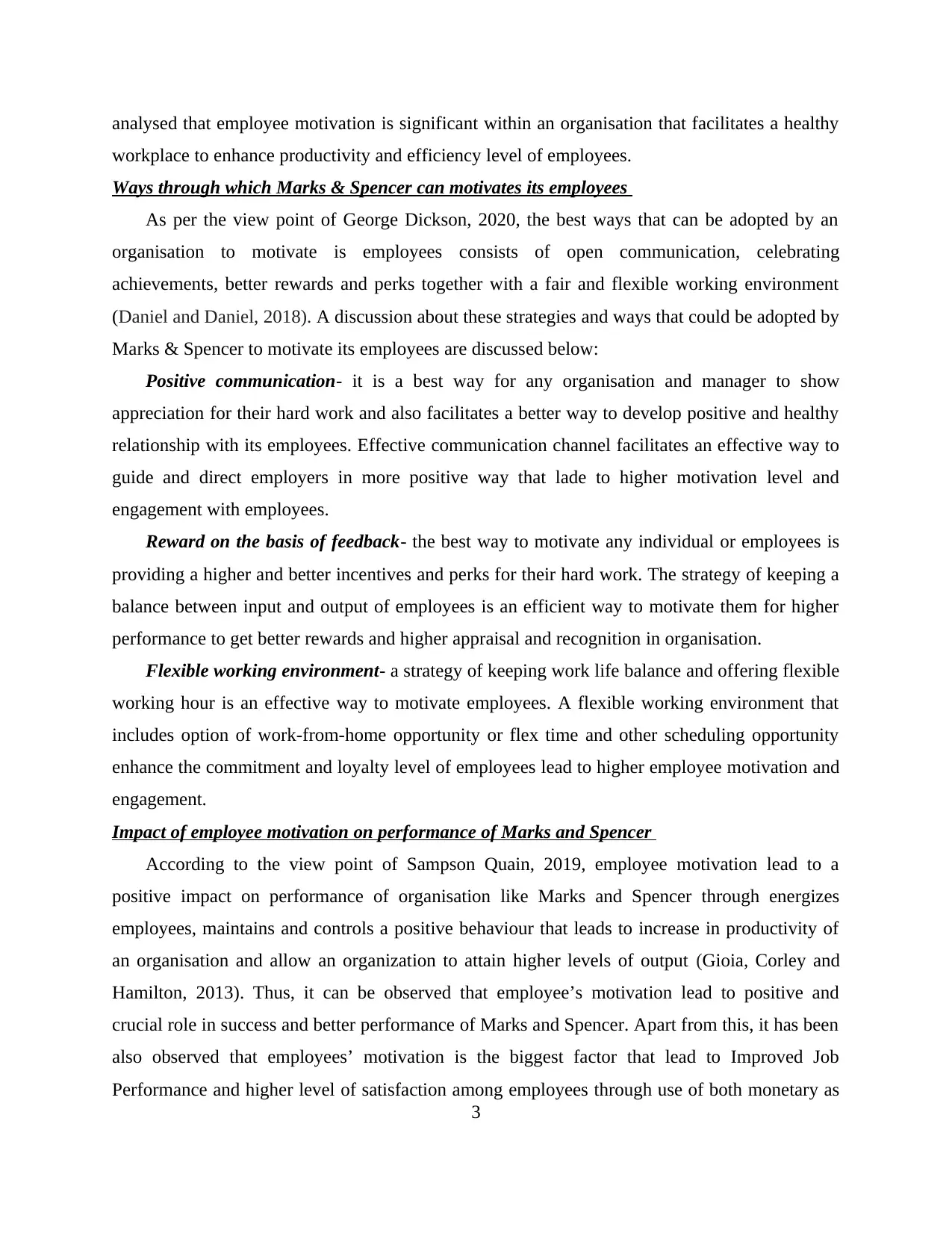
analysed that employee motivation is significant within an organisation that facilitates a healthy
workplace to enhance productivity and efficiency level of employees.
Ways through which Marks & Spencer can motivates its employees
As per the view point of George Dickson, 2020, the best ways that can be adopted by an
organisation to motivate is employees consists of open communication, celebrating
achievements, better rewards and perks together with a fair and flexible working environment
(Daniel and Daniel, 2018). A discussion about these strategies and ways that could be adopted by
Marks & Spencer to motivate its employees are discussed below:
Positive communication- it is a best way for any organisation and manager to show
appreciation for their hard work and also facilitates a better way to develop positive and healthy
relationship with its employees. Effective communication channel facilitates an effective way to
guide and direct employers in more positive way that lade to higher motivation level and
engagement with employees.
Reward on the basis of feedback- the best way to motivate any individual or employees is
providing a higher and better incentives and perks for their hard work. The strategy of keeping a
balance between input and output of employees is an efficient way to motivate them for higher
performance to get better rewards and higher appraisal and recognition in organisation.
Flexible working environment- a strategy of keeping work life balance and offering flexible
working hour is an effective way to motivate employees. A flexible working environment that
includes option of work-from-home opportunity or flex time and other scheduling opportunity
enhance the commitment and loyalty level of employees lead to higher employee motivation and
engagement.
Impact of employee motivation on performance of Marks and Spencer
According to the view point of Sampson Quain, 2019, employee motivation lead to a
positive impact on performance of organisation like Marks and Spencer through energizes
employees, maintains and controls a positive behaviour that leads to increase in productivity of
an organisation and allow an organization to attain higher levels of output (Gioia, Corley and
Hamilton, 2013). Thus, it can be observed that employee’s motivation lead to positive and
crucial role in success and better performance of Marks and Spencer. Apart from this, it has been
also observed that employees’ motivation is the biggest factor that lead to Improved Job
Performance and higher level of satisfaction among employees through use of both monetary as
3
workplace to enhance productivity and efficiency level of employees.
Ways through which Marks & Spencer can motivates its employees
As per the view point of George Dickson, 2020, the best ways that can be adopted by an
organisation to motivate is employees consists of open communication, celebrating
achievements, better rewards and perks together with a fair and flexible working environment
(Daniel and Daniel, 2018). A discussion about these strategies and ways that could be adopted by
Marks & Spencer to motivate its employees are discussed below:
Positive communication- it is a best way for any organisation and manager to show
appreciation for their hard work and also facilitates a better way to develop positive and healthy
relationship with its employees. Effective communication channel facilitates an effective way to
guide and direct employers in more positive way that lade to higher motivation level and
engagement with employees.
Reward on the basis of feedback- the best way to motivate any individual or employees is
providing a higher and better incentives and perks for their hard work. The strategy of keeping a
balance between input and output of employees is an efficient way to motivate them for higher
performance to get better rewards and higher appraisal and recognition in organisation.
Flexible working environment- a strategy of keeping work life balance and offering flexible
working hour is an effective way to motivate employees. A flexible working environment that
includes option of work-from-home opportunity or flex time and other scheduling opportunity
enhance the commitment and loyalty level of employees lead to higher employee motivation and
engagement.
Impact of employee motivation on performance of Marks and Spencer
According to the view point of Sampson Quain, 2019, employee motivation lead to a
positive impact on performance of organisation like Marks and Spencer through energizes
employees, maintains and controls a positive behaviour that leads to increase in productivity of
an organisation and allow an organization to attain higher levels of output (Gioia, Corley and
Hamilton, 2013). Thus, it can be observed that employee’s motivation lead to positive and
crucial role in success and better performance of Marks and Spencer. Apart from this, it has been
also observed that employees’ motivation is the biggest factor that lead to Improved Job
Performance and higher level of satisfaction among employees through use of both monetary as
3
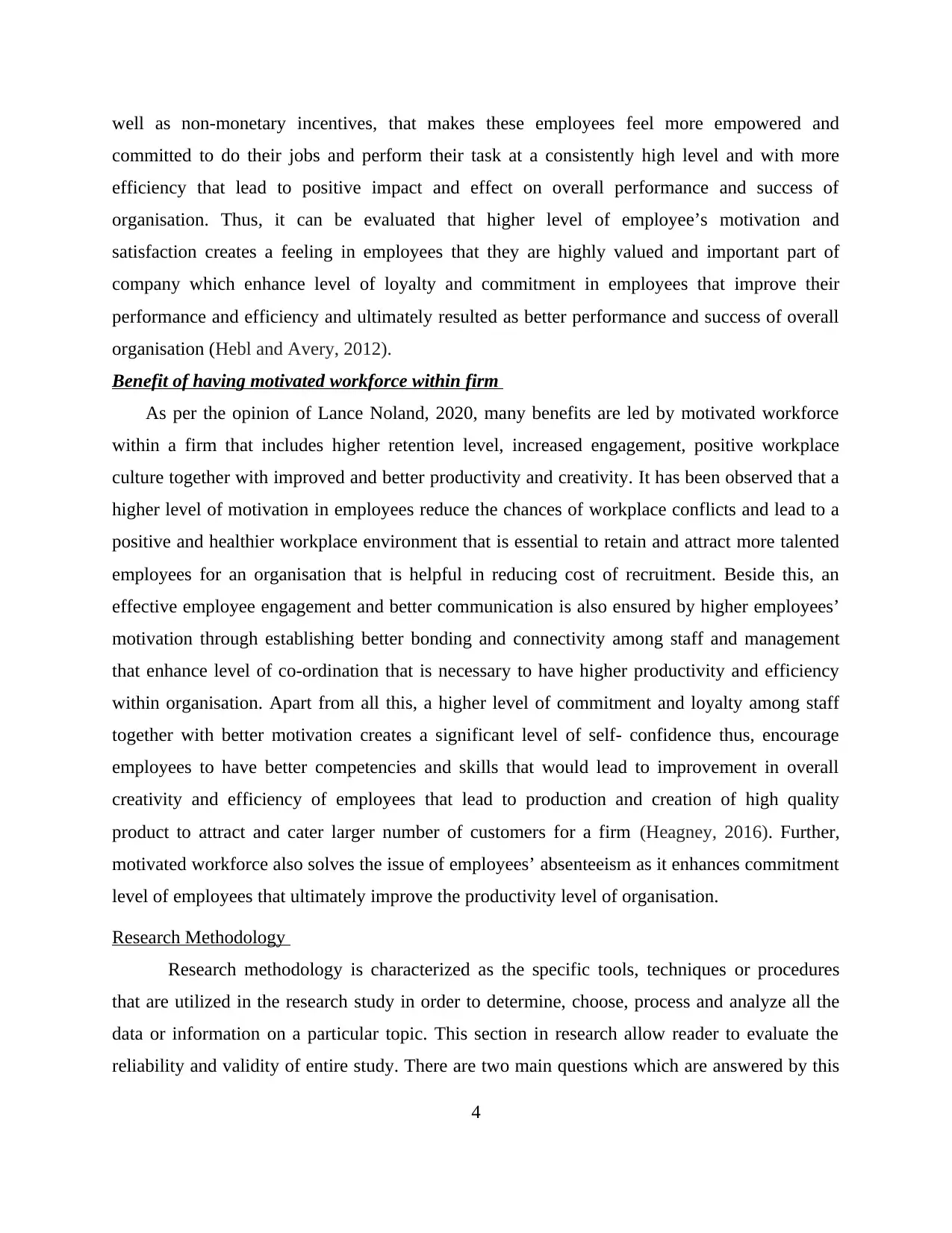
well as non-monetary incentives, that makes these employees feel more empowered and
committed to do their jobs and perform their task at a consistently high level and with more
efficiency that lead to positive impact and effect on overall performance and success of
organisation. Thus, it can be evaluated that higher level of employee’s motivation and
satisfaction creates a feeling in employees that they are highly valued and important part of
company which enhance level of loyalty and commitment in employees that improve their
performance and efficiency and ultimately resulted as better performance and success of overall
organisation (Hebl and Avery, 2012).
Benefit of having motivated workforce within firm
As per the opinion of Lance Noland, 2020, many benefits are led by motivated workforce
within a firm that includes higher retention level, increased engagement, positive workplace
culture together with improved and better productivity and creativity. It has been observed that a
higher level of motivation in employees reduce the chances of workplace conflicts and lead to a
positive and healthier workplace environment that is essential to retain and attract more talented
employees for an organisation that is helpful in reducing cost of recruitment. Beside this, an
effective employee engagement and better communication is also ensured by higher employees’
motivation through establishing better bonding and connectivity among staff and management
that enhance level of co-ordination that is necessary to have higher productivity and efficiency
within organisation. Apart from all this, a higher level of commitment and loyalty among staff
together with better motivation creates a significant level of self- confidence thus, encourage
employees to have better competencies and skills that would lead to improvement in overall
creativity and efficiency of employees that lead to production and creation of high quality
product to attract and cater larger number of customers for a firm (Heagney, 2016). Further,
motivated workforce also solves the issue of employees’ absenteeism as it enhances commitment
level of employees that ultimately improve the productivity level of organisation.
Research Methodology
Research methodology is characterized as the specific tools, techniques or procedures
that are utilized in the research study in order to determine, choose, process and analyze all the
data or information on a particular topic. This section in research allow reader to evaluate the
reliability and validity of entire study. There are two main questions which are answered by this
4
committed to do their jobs and perform their task at a consistently high level and with more
efficiency that lead to positive impact and effect on overall performance and success of
organisation. Thus, it can be evaluated that higher level of employee’s motivation and
satisfaction creates a feeling in employees that they are highly valued and important part of
company which enhance level of loyalty and commitment in employees that improve their
performance and efficiency and ultimately resulted as better performance and success of overall
organisation (Hebl and Avery, 2012).
Benefit of having motivated workforce within firm
As per the opinion of Lance Noland, 2020, many benefits are led by motivated workforce
within a firm that includes higher retention level, increased engagement, positive workplace
culture together with improved and better productivity and creativity. It has been observed that a
higher level of motivation in employees reduce the chances of workplace conflicts and lead to a
positive and healthier workplace environment that is essential to retain and attract more talented
employees for an organisation that is helpful in reducing cost of recruitment. Beside this, an
effective employee engagement and better communication is also ensured by higher employees’
motivation through establishing better bonding and connectivity among staff and management
that enhance level of co-ordination that is necessary to have higher productivity and efficiency
within organisation. Apart from all this, a higher level of commitment and loyalty among staff
together with better motivation creates a significant level of self- confidence thus, encourage
employees to have better competencies and skills that would lead to improvement in overall
creativity and efficiency of employees that lead to production and creation of high quality
product to attract and cater larger number of customers for a firm (Heagney, 2016). Further,
motivated workforce also solves the issue of employees’ absenteeism as it enhances commitment
level of employees that ultimately improve the productivity level of organisation.
Research Methodology
Research methodology is characterized as the specific tools, techniques or procedures
that are utilized in the research study in order to determine, choose, process and analyze all the
data or information on a particular topic. This section in research allow reader to evaluate the
reliability and validity of entire study. There are two main questions which are answered by this
4
⊘ This is a preview!⊘
Do you want full access?
Subscribe today to unlock all pages.

Trusted by 1+ million students worldwide
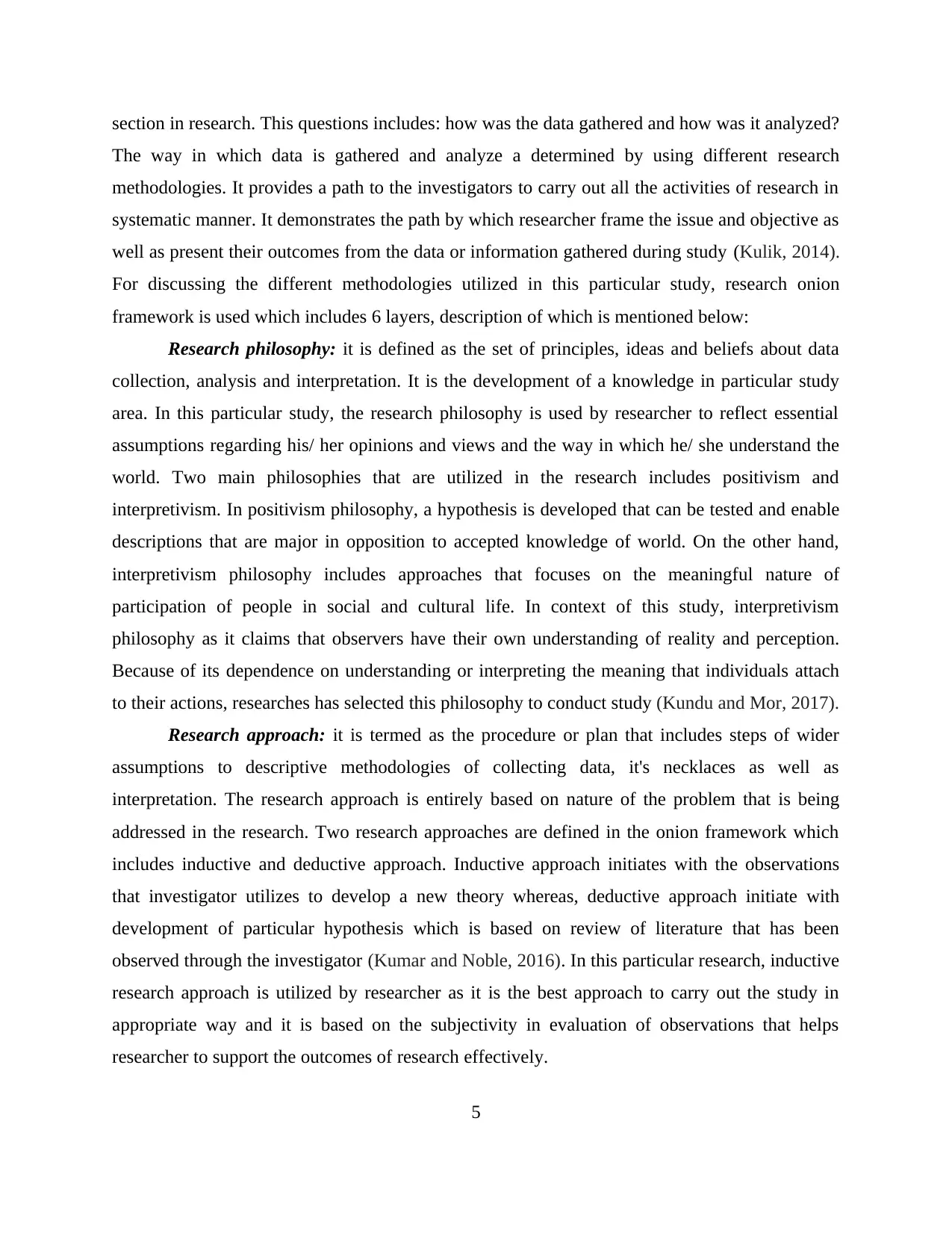
section in research. This questions includes: how was the data gathered and how was it analyzed?
The way in which data is gathered and analyze a determined by using different research
methodologies. It provides a path to the investigators to carry out all the activities of research in
systematic manner. It demonstrates the path by which researcher frame the issue and objective as
well as present their outcomes from the data or information gathered during study (Kulik, 2014).
For discussing the different methodologies utilized in this particular study, research onion
framework is used which includes 6 layers, description of which is mentioned below:
Research philosophy: it is defined as the set of principles, ideas and beliefs about data
collection, analysis and interpretation. It is the development of a knowledge in particular study
area. In this particular study, the research philosophy is used by researcher to reflect essential
assumptions regarding his/ her opinions and views and the way in which he/ she understand the
world. Two main philosophies that are utilized in the research includes positivism and
interpretivism. In positivism philosophy, a hypothesis is developed that can be tested and enable
descriptions that are major in opposition to accepted knowledge of world. On the other hand,
interpretivism philosophy includes approaches that focuses on the meaningful nature of
participation of people in social and cultural life. In context of this study, interpretivism
philosophy as it claims that observers have their own understanding of reality and perception.
Because of its dependence on understanding or interpreting the meaning that individuals attach
to their actions, researches has selected this philosophy to conduct study (Kundu and Mor, 2017).
Research approach: it is termed as the procedure or plan that includes steps of wider
assumptions to descriptive methodologies of collecting data, it's necklaces as well as
interpretation. The research approach is entirely based on nature of the problem that is being
addressed in the research. Two research approaches are defined in the onion framework which
includes inductive and deductive approach. Inductive approach initiates with the observations
that investigator utilizes to develop a new theory whereas, deductive approach initiate with
development of particular hypothesis which is based on review of literature that has been
observed through the investigator (Kumar and Noble, 2016). In this particular research, inductive
research approach is utilized by researcher as it is the best approach to carry out the study in
appropriate way and it is based on the subjectivity in evaluation of observations that helps
researcher to support the outcomes of research effectively.
5
The way in which data is gathered and analyze a determined by using different research
methodologies. It provides a path to the investigators to carry out all the activities of research in
systematic manner. It demonstrates the path by which researcher frame the issue and objective as
well as present their outcomes from the data or information gathered during study (Kulik, 2014).
For discussing the different methodologies utilized in this particular study, research onion
framework is used which includes 6 layers, description of which is mentioned below:
Research philosophy: it is defined as the set of principles, ideas and beliefs about data
collection, analysis and interpretation. It is the development of a knowledge in particular study
area. In this particular study, the research philosophy is used by researcher to reflect essential
assumptions regarding his/ her opinions and views and the way in which he/ she understand the
world. Two main philosophies that are utilized in the research includes positivism and
interpretivism. In positivism philosophy, a hypothesis is developed that can be tested and enable
descriptions that are major in opposition to accepted knowledge of world. On the other hand,
interpretivism philosophy includes approaches that focuses on the meaningful nature of
participation of people in social and cultural life. In context of this study, interpretivism
philosophy as it claims that observers have their own understanding of reality and perception.
Because of its dependence on understanding or interpreting the meaning that individuals attach
to their actions, researches has selected this philosophy to conduct study (Kundu and Mor, 2017).
Research approach: it is termed as the procedure or plan that includes steps of wider
assumptions to descriptive methodologies of collecting data, it's necklaces as well as
interpretation. The research approach is entirely based on nature of the problem that is being
addressed in the research. Two research approaches are defined in the onion framework which
includes inductive and deductive approach. Inductive approach initiates with the observations
that investigator utilizes to develop a new theory whereas, deductive approach initiate with
development of particular hypothesis which is based on review of literature that has been
observed through the investigator (Kumar and Noble, 2016). In this particular research, inductive
research approach is utilized by researcher as it is the best approach to carry out the study in
appropriate way and it is based on the subjectivity in evaluation of observations that helps
researcher to support the outcomes of research effectively.
5
Paraphrase This Document
Need a fresh take? Get an instant paraphrase of this document with our AI Paraphraser
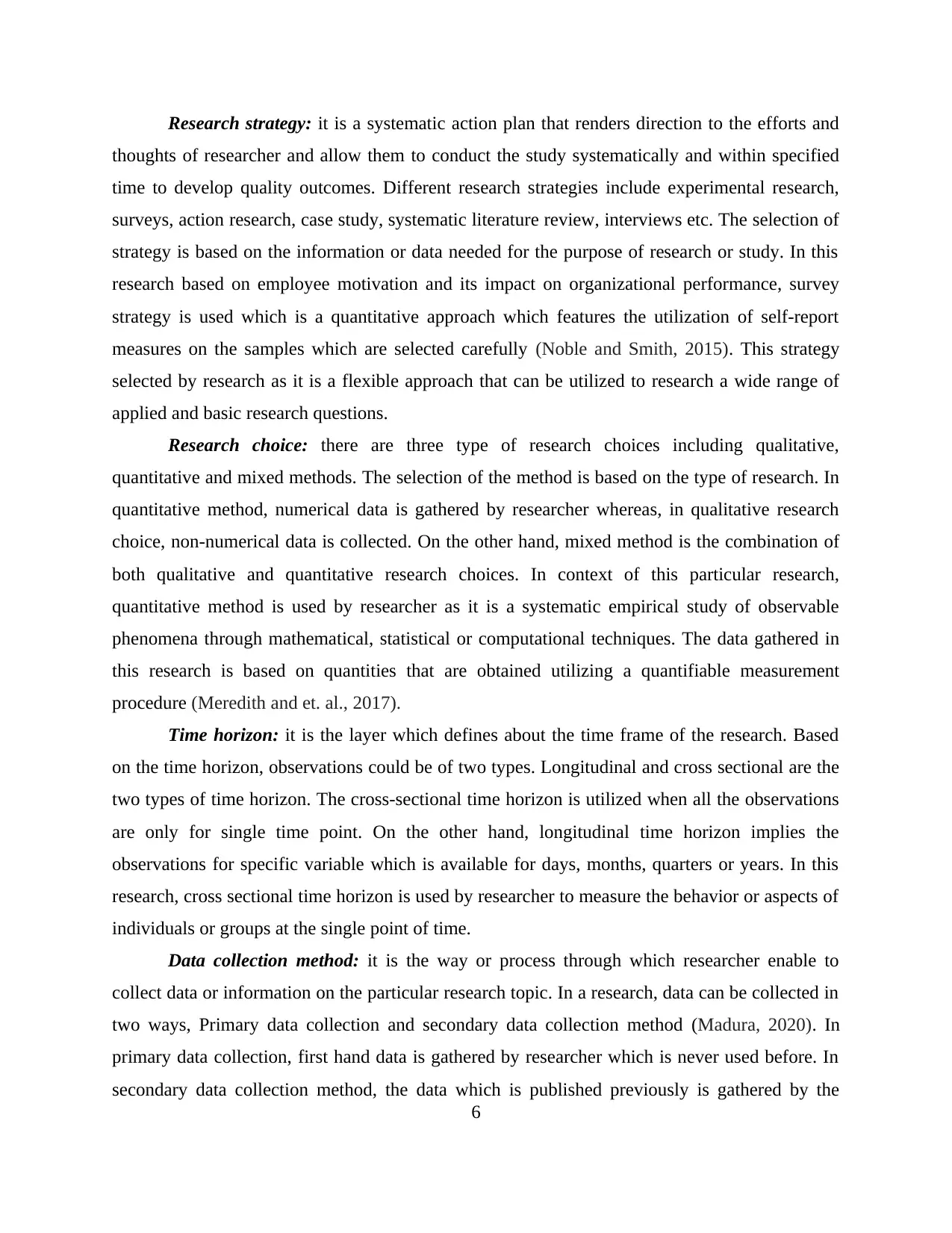
Research strategy: it is a systematic action plan that renders direction to the efforts and
thoughts of researcher and allow them to conduct the study systematically and within specified
time to develop quality outcomes. Different research strategies include experimental research,
surveys, action research, case study, systematic literature review, interviews etc. The selection of
strategy is based on the information or data needed for the purpose of research or study. In this
research based on employee motivation and its impact on organizational performance, survey
strategy is used which is a quantitative approach which features the utilization of self-report
measures on the samples which are selected carefully (Noble and Smith, 2015). This strategy
selected by research as it is a flexible approach that can be utilized to research a wide range of
applied and basic research questions.
Research choice: there are three type of research choices including qualitative,
quantitative and mixed methods. The selection of the method is based on the type of research. In
quantitative method, numerical data is gathered by researcher whereas, in qualitative research
choice, non-numerical data is collected. On the other hand, mixed method is the combination of
both qualitative and quantitative research choices. In context of this particular research,
quantitative method is used by researcher as it is a systematic empirical study of observable
phenomena through mathematical, statistical or computational techniques. The data gathered in
this research is based on quantities that are obtained utilizing a quantifiable measurement
procedure (Meredith and et. al., 2017).
Time horizon: it is the layer which defines about the time frame of the research. Based
on the time horizon, observations could be of two types. Longitudinal and cross sectional are the
two types of time horizon. The cross-sectional time horizon is utilized when all the observations
are only for single time point. On the other hand, longitudinal time horizon implies the
observations for specific variable which is available for days, months, quarters or years. In this
research, cross sectional time horizon is used by researcher to measure the behavior or aspects of
individuals or groups at the single point of time.
Data collection method: it is the way or process through which researcher enable to
collect data or information on the particular research topic. In a research, data can be collected in
two ways, Primary data collection and secondary data collection method (Madura, 2020). In
primary data collection, first hand data is gathered by researcher which is never used before. In
secondary data collection method, the data which is published previously is gathered by the
6
thoughts of researcher and allow them to conduct the study systematically and within specified
time to develop quality outcomes. Different research strategies include experimental research,
surveys, action research, case study, systematic literature review, interviews etc. The selection of
strategy is based on the information or data needed for the purpose of research or study. In this
research based on employee motivation and its impact on organizational performance, survey
strategy is used which is a quantitative approach which features the utilization of self-report
measures on the samples which are selected carefully (Noble and Smith, 2015). This strategy
selected by research as it is a flexible approach that can be utilized to research a wide range of
applied and basic research questions.
Research choice: there are three type of research choices including qualitative,
quantitative and mixed methods. The selection of the method is based on the type of research. In
quantitative method, numerical data is gathered by researcher whereas, in qualitative research
choice, non-numerical data is collected. On the other hand, mixed method is the combination of
both qualitative and quantitative research choices. In context of this particular research,
quantitative method is used by researcher as it is a systematic empirical study of observable
phenomena through mathematical, statistical or computational techniques. The data gathered in
this research is based on quantities that are obtained utilizing a quantifiable measurement
procedure (Meredith and et. al., 2017).
Time horizon: it is the layer which defines about the time frame of the research. Based
on the time horizon, observations could be of two types. Longitudinal and cross sectional are the
two types of time horizon. The cross-sectional time horizon is utilized when all the observations
are only for single time point. On the other hand, longitudinal time horizon implies the
observations for specific variable which is available for days, months, quarters or years. In this
research, cross sectional time horizon is used by researcher to measure the behavior or aspects of
individuals or groups at the single point of time.
Data collection method: it is the way or process through which researcher enable to
collect data or information on the particular research topic. In a research, data can be collected in
two ways, Primary data collection and secondary data collection method (Madura, 2020). In
primary data collection, first hand data is gathered by researcher which is never used before. In
secondary data collection method, the data which is published previously is gathered by the
6
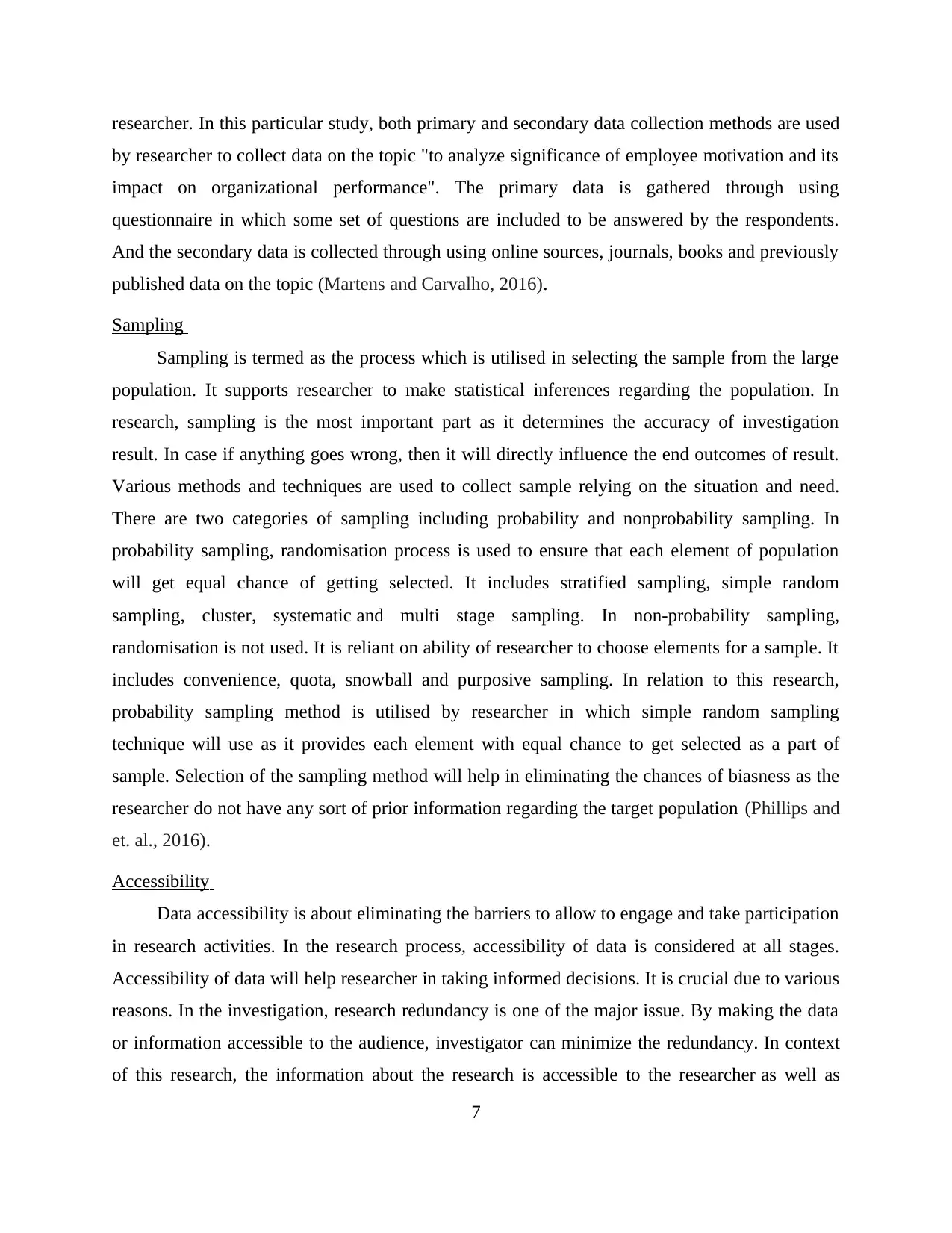
researcher. In this particular study, both primary and secondary data collection methods are used
by researcher to collect data on the topic "to analyze significance of employee motivation and its
impact on organizational performance". The primary data is gathered through using
questionnaire in which some set of questions are included to be answered by the respondents.
And the secondary data is collected through using online sources, journals, books and previously
published data on the topic (Martens and Carvalho, 2016).
Sampling
Sampling is termed as the process which is utilised in selecting the sample from the large
population. It supports researcher to make statistical inferences regarding the population. In
research, sampling is the most important part as it determines the accuracy of investigation
result. In case if anything goes wrong, then it will directly influence the end outcomes of result.
Various methods and techniques are used to collect sample relying on the situation and need.
There are two categories of sampling including probability and nonprobability sampling. In
probability sampling, randomisation process is used to ensure that each element of population
will get equal chance of getting selected. It includes stratified sampling, simple random
sampling, cluster, systematic and multi stage sampling. In non-probability sampling,
randomisation is not used. It is reliant on ability of researcher to choose elements for a sample. It
includes convenience, quota, snowball and purposive sampling. In relation to this research,
probability sampling method is utilised by researcher in which simple random sampling
technique will use as it provides each element with equal chance to get selected as a part of
sample. Selection of the sampling method will help in eliminating the chances of biasness as the
researcher do not have any sort of prior information regarding the target population (Phillips and
et. al., 2016).
Accessibility
Data accessibility is about eliminating the barriers to allow to engage and take participation
in research activities. In the research process, accessibility of data is considered at all stages.
Accessibility of data will help researcher in taking informed decisions. It is crucial due to various
reasons. In the investigation, research redundancy is one of the major issue. By making the data
or information accessible to the audience, investigator can minimize the redundancy. In context
of this research, the information about the research is accessible to the researcher as well as
7
by researcher to collect data on the topic "to analyze significance of employee motivation and its
impact on organizational performance". The primary data is gathered through using
questionnaire in which some set of questions are included to be answered by the respondents.
And the secondary data is collected through using online sources, journals, books and previously
published data on the topic (Martens and Carvalho, 2016).
Sampling
Sampling is termed as the process which is utilised in selecting the sample from the large
population. It supports researcher to make statistical inferences regarding the population. In
research, sampling is the most important part as it determines the accuracy of investigation
result. In case if anything goes wrong, then it will directly influence the end outcomes of result.
Various methods and techniques are used to collect sample relying on the situation and need.
There are two categories of sampling including probability and nonprobability sampling. In
probability sampling, randomisation process is used to ensure that each element of population
will get equal chance of getting selected. It includes stratified sampling, simple random
sampling, cluster, systematic and multi stage sampling. In non-probability sampling,
randomisation is not used. It is reliant on ability of researcher to choose elements for a sample. It
includes convenience, quota, snowball and purposive sampling. In relation to this research,
probability sampling method is utilised by researcher in which simple random sampling
technique will use as it provides each element with equal chance to get selected as a part of
sample. Selection of the sampling method will help in eliminating the chances of biasness as the
researcher do not have any sort of prior information regarding the target population (Phillips and
et. al., 2016).
Accessibility
Data accessibility is about eliminating the barriers to allow to engage and take participation
in research activities. In the research process, accessibility of data is considered at all stages.
Accessibility of data will help researcher in taking informed decisions. It is crucial due to various
reasons. In the investigation, research redundancy is one of the major issue. By making the data
or information accessible to the audience, investigator can minimize the redundancy. In context
of this research, the information about the research is accessible to the researcher as well as
7
⊘ This is a preview!⊘
Do you want full access?
Subscribe today to unlock all pages.

Trusted by 1+ million students worldwide
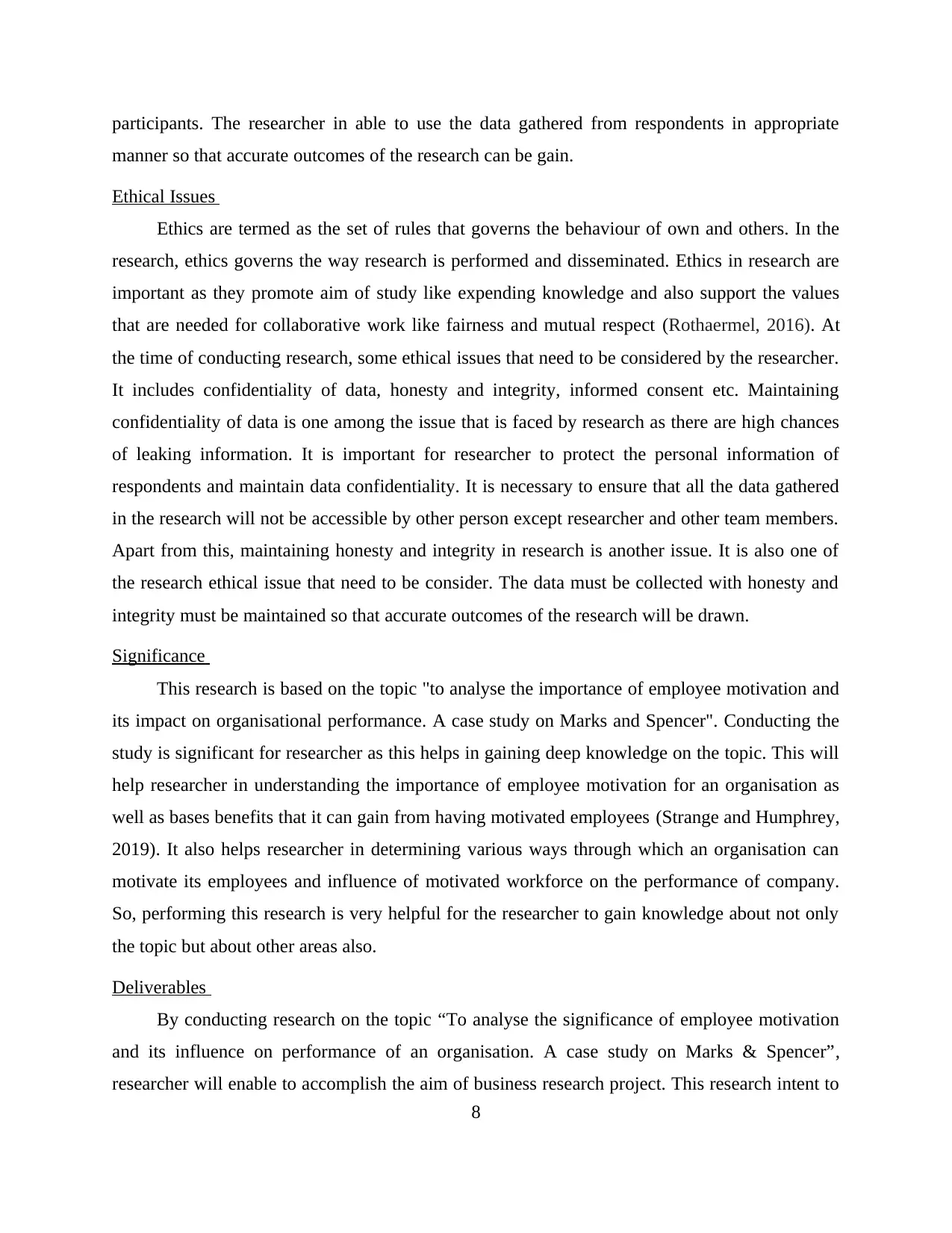
participants. The researcher in able to use the data gathered from respondents in appropriate
manner so that accurate outcomes of the research can be gain.
Ethical Issues
Ethics are termed as the set of rules that governs the behaviour of own and others. In the
research, ethics governs the way research is performed and disseminated. Ethics in research are
important as they promote aim of study like expending knowledge and also support the values
that are needed for collaborative work like fairness and mutual respect (Rothaermel, 2016). At
the time of conducting research, some ethical issues that need to be considered by the researcher.
It includes confidentiality of data, honesty and integrity, informed consent etc. Maintaining
confidentiality of data is one among the issue that is faced by research as there are high chances
of leaking information. It is important for researcher to protect the personal information of
respondents and maintain data confidentiality. It is necessary to ensure that all the data gathered
in the research will not be accessible by other person except researcher and other team members.
Apart from this, maintaining honesty and integrity in research is another issue. It is also one of
the research ethical issue that need to be consider. The data must be collected with honesty and
integrity must be maintained so that accurate outcomes of the research will be drawn.
Significance
This research is based on the topic "to analyse the importance of employee motivation and
its impact on organisational performance. A case study on Marks and Spencer". Conducting the
study is significant for researcher as this helps in gaining deep knowledge on the topic. This will
help researcher in understanding the importance of employee motivation for an organisation as
well as bases benefits that it can gain from having motivated employees (Strange and Humphrey,
2019). It also helps researcher in determining various ways through which an organisation can
motivate its employees and influence of motivated workforce on the performance of company.
So, performing this research is very helpful for the researcher to gain knowledge about not only
the topic but about other areas also.
Deliverables
By conducting research on the topic “To analyse the significance of employee motivation
and its influence on performance of an organisation. A case study on Marks & Spencer”,
researcher will enable to accomplish the aim of business research project. This research intent to
8
manner so that accurate outcomes of the research can be gain.
Ethical Issues
Ethics are termed as the set of rules that governs the behaviour of own and others. In the
research, ethics governs the way research is performed and disseminated. Ethics in research are
important as they promote aim of study like expending knowledge and also support the values
that are needed for collaborative work like fairness and mutual respect (Rothaermel, 2016). At
the time of conducting research, some ethical issues that need to be considered by the researcher.
It includes confidentiality of data, honesty and integrity, informed consent etc. Maintaining
confidentiality of data is one among the issue that is faced by research as there are high chances
of leaking information. It is important for researcher to protect the personal information of
respondents and maintain data confidentiality. It is necessary to ensure that all the data gathered
in the research will not be accessible by other person except researcher and other team members.
Apart from this, maintaining honesty and integrity in research is another issue. It is also one of
the research ethical issue that need to be consider. The data must be collected with honesty and
integrity must be maintained so that accurate outcomes of the research will be drawn.
Significance
This research is based on the topic "to analyse the importance of employee motivation and
its impact on organisational performance. A case study on Marks and Spencer". Conducting the
study is significant for researcher as this helps in gaining deep knowledge on the topic. This will
help researcher in understanding the importance of employee motivation for an organisation as
well as bases benefits that it can gain from having motivated employees (Strange and Humphrey,
2019). It also helps researcher in determining various ways through which an organisation can
motivate its employees and influence of motivated workforce on the performance of company.
So, performing this research is very helpful for the researcher to gain knowledge about not only
the topic but about other areas also.
Deliverables
By conducting research on the topic “To analyse the significance of employee motivation
and its influence on performance of an organisation. A case study on Marks & Spencer”,
researcher will enable to accomplish the aim of business research project. This research intent to
8
Paraphrase This Document
Need a fresh take? Get an instant paraphrase of this document with our AI Paraphraser
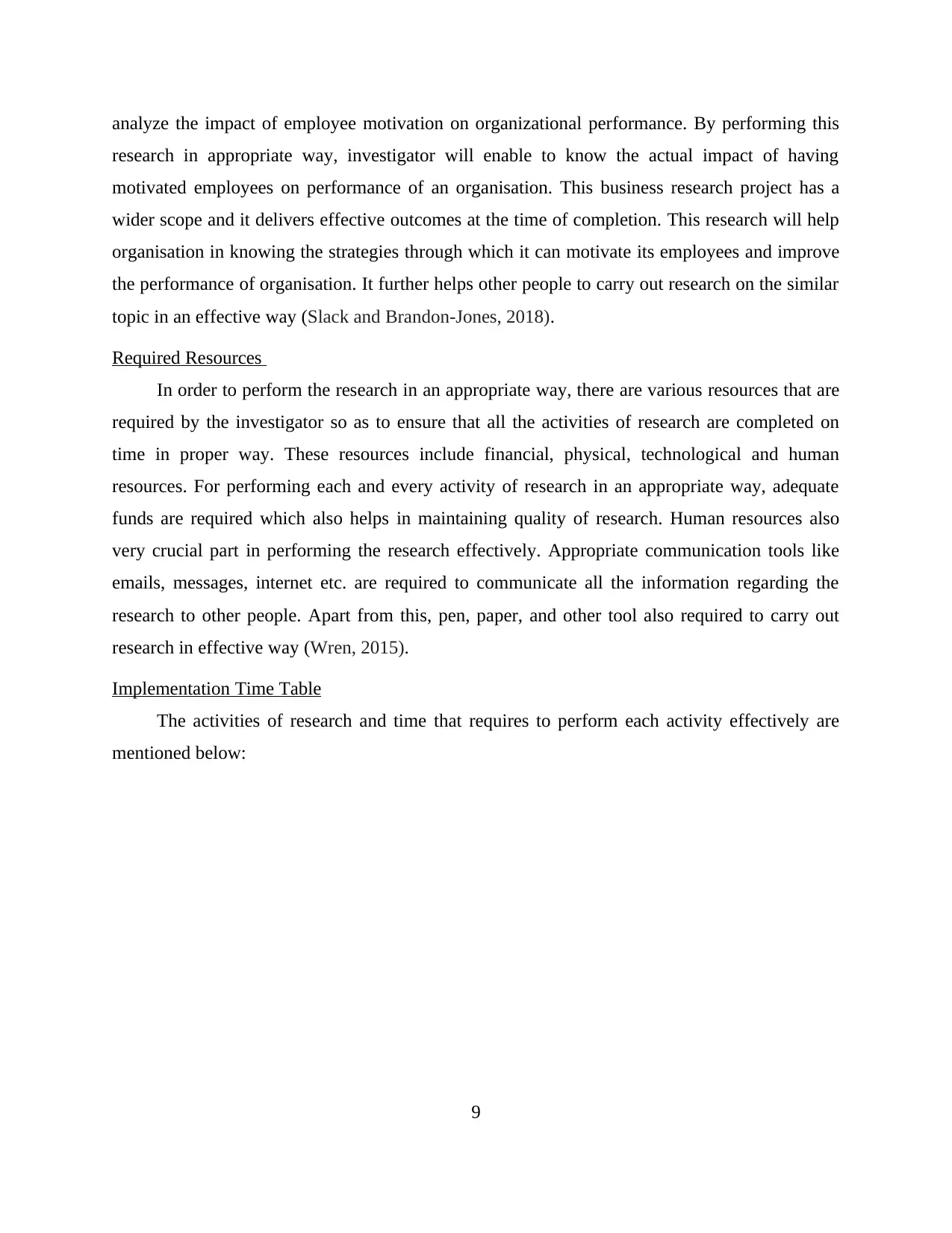
analyze the impact of employee motivation on organizational performance. By performing this
research in appropriate way, investigator will enable to know the actual impact of having
motivated employees on performance of an organisation. This business research project has a
wider scope and it delivers effective outcomes at the time of completion. This research will help
organisation in knowing the strategies through which it can motivate its employees and improve
the performance of organisation. It further helps other people to carry out research on the similar
topic in an effective way (Slack and Brandon-Jones, 2018).
Required Resources
In order to perform the research in an appropriate way, there are various resources that are
required by the investigator so as to ensure that all the activities of research are completed on
time in proper way. These resources include financial, physical, technological and human
resources. For performing each and every activity of research in an appropriate way, adequate
funds are required which also helps in maintaining quality of research. Human resources also
very crucial part in performing the research effectively. Appropriate communication tools like
emails, messages, internet etc. are required to communicate all the information regarding the
research to other people. Apart from this, pen, paper, and other tool also required to carry out
research in effective way (Wren, 2015).
Implementation Time Table
The activities of research and time that requires to perform each activity effectively are
mentioned below:
9
research in appropriate way, investigator will enable to know the actual impact of having
motivated employees on performance of an organisation. This business research project has a
wider scope and it delivers effective outcomes at the time of completion. This research will help
organisation in knowing the strategies through which it can motivate its employees and improve
the performance of organisation. It further helps other people to carry out research on the similar
topic in an effective way (Slack and Brandon-Jones, 2018).
Required Resources
In order to perform the research in an appropriate way, there are various resources that are
required by the investigator so as to ensure that all the activities of research are completed on
time in proper way. These resources include financial, physical, technological and human
resources. For performing each and every activity of research in an appropriate way, adequate
funds are required which also helps in maintaining quality of research. Human resources also
very crucial part in performing the research effectively. Appropriate communication tools like
emails, messages, internet etc. are required to communicate all the information regarding the
research to other people. Apart from this, pen, paper, and other tool also required to carry out
research in effective way (Wren, 2015).
Implementation Time Table
The activities of research and time that requires to perform each activity effectively are
mentioned below:
9
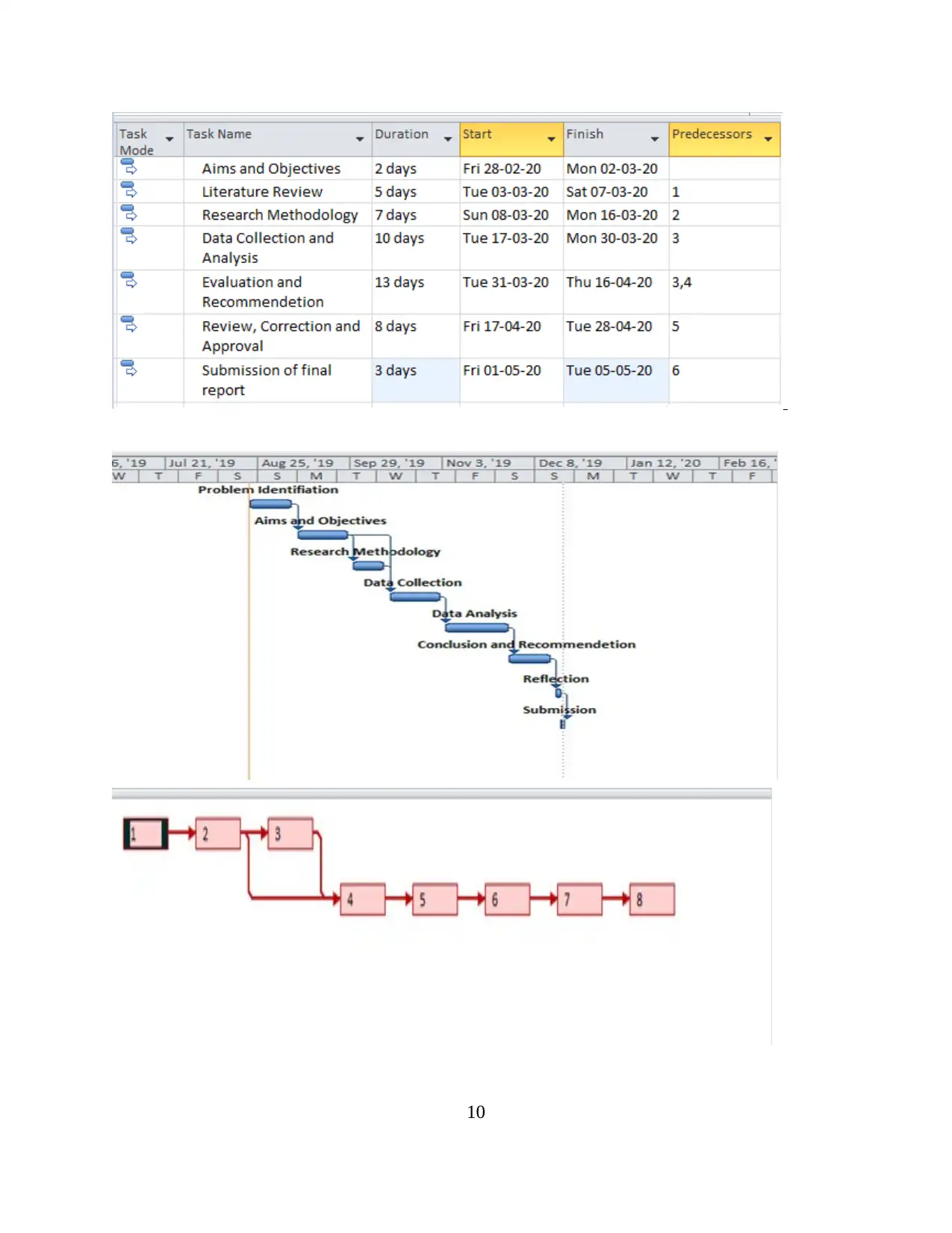
10
⊘ This is a preview!⊘
Do you want full access?
Subscribe today to unlock all pages.

Trusted by 1+ million students worldwide
1 out of 16
Related Documents
Your All-in-One AI-Powered Toolkit for Academic Success.
+13062052269
info@desklib.com
Available 24*7 on WhatsApp / Email
![[object Object]](/_next/static/media/star-bottom.7253800d.svg)
Unlock your academic potential
Copyright © 2020–2025 A2Z Services. All Rights Reserved. Developed and managed by ZUCOL.





